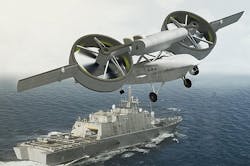Lockheed Martin chooses flight-control computer systems from NAI for DARPA ARES unmanned helicopter
Lockheed Martin is choosing NAI to provide embedded computing navigation systems for the Aerial Reconfigurable Embedded System (ARES) vertical takeoff and landing (VTOL) demonstrator program of the U.S. Defense Advanced Research Projects Agency (DARPA) in Arlington, Va.
The DARPA ARES program, which is in its third and final phase, is developing an unmanned VTOL aircraft that can transport military cargo, warfighters, and other important military payloads into rugged and dangerous areas.
Lockheed Martin engineers are designing the ARES aircraft to have its own power system, fuel, digital flight controls, and remote command-and-control interfaces. Twin tilting ducted fans are expected to provide efficient hovering and landing capabilities in a compact configuration, with rapid conversion to high-speed cruise flight.
NAI experts are meeting the ARES program's vehicle management computer (VMC) and actuator interface unit (AIU) requirements with the company's commercial-off-the-shelf (COTS) SIU6 chassis.
Built on NAI's custom-on-standard architecture (COSA) platform, the SIU6 chassis has a PowerPC-based 6U VME single board computer and multi-function I/O boards to enable Lockheed Martin to mix and match functionality based on the ARES application demands.
As part of the ARES navigation system, the SIU6 sensor interface unit enables Lockheed Martin to populate each board with function-specific modules. This modular architecture offers as many as 10 different or same functions from an assortment of low-power, high-density modules, NAI officials say.
Functions include programmable discretes, analog I/O (A/D, D/A & RTD), communications (RS-232/422/485 & ARINC-429), LVDT measurement, RVDT simulation, and LVDT/RVDT AC excitation.
The size, weight, power, and cost (SWaP-C)-efficient design increases packaging density, saves enclosure slots, and reduces power consumption, NAI officials say. In addition, the SIU6 incorporates automatic background built-in-test (BIT) that always is enabled and continually checks the health of each channel.
The NAI embedded computing components makes the ARES vehicle management computer triple redundant. The VMC controls actuators and various I/O for advanced autonomous flight control. The VMC also communicates with the actuator interface unit, which has redundancy by using two AIUs in the system.
For more information contact North Atlantic Industries online at www.naii.com, Lockheed Martin Skunk Works at www.lockheedmartin.com/us/aeronautics/skunkworks, or DARPA at www.darpa.mil.
